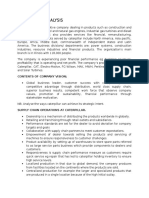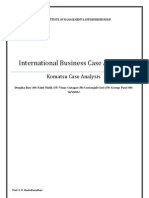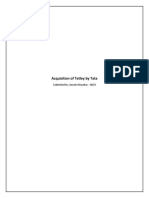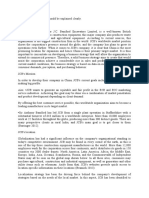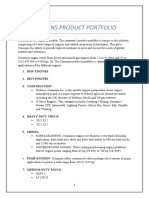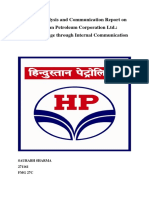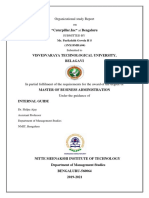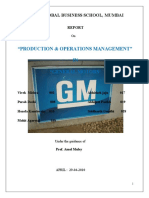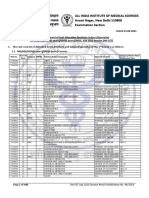Cat Vs Komatsu 4 Dekade
Cat Vs Komatsu 4 Dekade
Uploaded by
Aji AjaCopyright:
Available Formats
Cat Vs Komatsu 4 Dekade
Cat Vs Komatsu 4 Dekade
Uploaded by
Aji AjaOriginal Title
Copyright
Available Formats
Share this document
Did you find this document useful?
Is this content inappropriate?
Copyright:
Available Formats
Cat Vs Komatsu 4 Dekade
Cat Vs Komatsu 4 Dekade
Uploaded by
Aji AjaCopyright:
Available Formats
Caterpillar vs.
Komatsu: Four Decades of Global Competition Caterpillar: Market Dominator of Construction & Mining Equipment, Machinery For more than 75 years, Caterpillar Inc. has been building the world's infrastructure, and in partnership with Caterpillar dealers, has allowed for positive and sustainable change on every continent. A Fortune 100 company, Caterpillar is the world's leading manufacturer of construction and mining equipment, diesel and natural gas engines, and industrial gas turbines. The company is a technology leader in construction, transportation, mining, forestry, energy, logistics, electronics, financing and electric power generation.
In the first half of 2002, Caterpillar posted profit of $280 million or 81 cents per share, the total of sales and revenues of $9.70 billion. More than half of all sales were to customers outside of the United States, maintaining Caterpillar's status of an international business and leading U.S. exporter. Caterpillar products and components are manufactured in 50 U.S. facilities and in 65 other locations in 23 countries around the globe. During the year 2001 Caterpillar invested almost $700 million in research and technological development. This allowed for the employees of Caterpillar to receive over 2,800 patents since 1996.
History - Caterpillar
Caterpillar Inc. was founded in 1925 when the Holt Manufacturing Co. and the C. L. Best Tractor Co. merged to form Caterpillar Tractor Co. Caterpillar aimed to be the leader in providing the best value in machines, engines and support services for customers dedicated to building the world's infrastructure, and developing and transporting its resources. Fifteen years later in 1940, the Caterpillar product line now included motor graders, blade graders, elevating graders, tractors and electrical generating sets. With the outbreak of World War 2, Caterpillar track-type tractors, motor graders, generators sets, and a special engine for the M4 tank were bought in great quantities by the U.S. in its war effort. In 1981, Caterpillar Financial Services Corp. was formed to offer equipment financing options to customers worldwide. This positive step in expansion has allowed for Caterpillar to become a major competitor in the international business world. A profile has been listed below to further explain the impact Caterpillar Financial Services has made regarding expansion of the corporation. Profile - Caterpillar Financial Services Based in Nashville, Tenn., Caterpillar Financial Services Corporation is the financial arm of the Fortune 500 company, Caterpillar Inc. It offers a wide range of financing alternatives for the complete line of Caterpillar equipment, solar gas turbines, products equipped with Cat components, fork lift trucks manufactured by Mitsubishi Caterpillar Forklift of America, Inc., and related products sold through Cat dealers. Caterpillar Financial Services also extends loans to customers and dealers around the world. Serving customers around the globe with offices and subsidiaries located throughout the Americas, Australia, Europe, and Asia, Caterpillar Financial offers competitive rates and customized financing options to meet customers' financial needs. Major Achievements - Caterpillar Financial Caterpillar Financial continued its growth in 2001 with record revenues of $1.62 billion. The increase of $177 million compared with 2000 was primarily related to a larger portfolio and increased gains on sales of receivables. Profit after tax was a record $212 million, an increase of $53 million from last year. The increase in profit resulted primarily from the larger portfolio. Caterpillar Financial has also managed to penetrate multiple international markets throughout the world, creating an international dealer network. This process of internationalization continues to grow at an ever increasing pace and has allowed for Caterpillar to maintain the strategic international
business status that it have today. Caterpillar dealerships have continued successfully to work with Caterpillar Financial services around the world, serving customers where they work and live. Caterpillars Financial Services global locations include Korea, Malaysia, Philippines, Singapore, Thailand, Japan, Australia, Belgium, Czech Republic, Denmark, France, Germany (including Austria, Hungary, and Switzerland), Ireland, Italy, Netherlands, Norway, Poland, Portugal, Spain, Sweden, United Kingdom, Brazil, Chile, Mexico, two offices in Canada, and four regional offices within the United States. In countries where Caterpillar does not yet have a physical presence, they provide financing through their Global Accounts Division. History Caterpillar: Other divisions Five years after the war, in 1950, Caterpillar Tractor Co. Ltd. in Great Britain is established, This is the first of many overseas operations created to help manage foreign exchange shortages, tariffs, import controls and better serve customers around the world. This expansion of Caterpillar into Europe allowed for Caterpillar to take its products and services into the international market. The company next decided to create a separate sales and marketing division just for engine customers. Since the creation of the Engine Division, Caterpillar Inc has become a major player within the diesel engine market and now generates 25% of the total sales of Caterpillar Inc. After Caterpillar had penetrated the market within the UK, the company next decided to attempt to enter the Japanese market.
Komatsu The main competitors that Caterpillar faced within the Japanese market were Komatsu and Mitsubishi. The company of Komatsu was especially dangerous to Caterpillar due to the fact that it was the second largest EME company worldwide. Due to this danger Caterpillar decided to penetrate the Japanese market through a joint venture with Mitsubishi. The result of this was that Caterpillar and Mitsubishi Heavy Industries Ltd. formed one of the first joint ventures in Japan to include partial U.S. ownership. Caterpillar Mitsubishi Ltd. started production in 1965, has been renamed Shin Caterpillar Mitsubishi Ltd., and is now the No. 2 maker of construction and mining equipment in Japan. Komatsu now understood the competition it faced but still held a 60% market share within Japan. With the threat of the Caterpillar/Mitsubishi venture taking place Komatsu decided to attempt a revitalization of the company. Since Komatsu mainly exported whole machines, the company soon realized that needed to also expand into other markets and set up assembly plans in places like Brazil and Mexico. The management staff in Komatsu began to establish business relationships with multiple countries,
primarily focusing on third world countries and the communist states that existed during that time. Komatsu lacked and effective dealer network, which forced the company to rely on nonexclusive dealerships. This ultimately led to Komatsu receiving smaller contracts than Caterpillar. Caterpillar's global dealer network provided a key competitive edge - customers deal with people they know and trust. This is due to the fact that almost all dealerships are independent and locally owned. Many have relationships with their customers that span at least two generations. Caterpillar dealers serve equipment, service and financing needs for customers in more than 200 countries. The rental services are also offered at more than 1,200 outlets worldwide. Sources of success Komatsu Komatsu has been a leader in innovative quality-control initiatives ever since President Yashinari Kawai decided to leverage MITIs opening of the EME industry in 1963, and fight back in the face of the Caterpillar/Mitsubishi joint venture. He set 2 goals: acquire the best advanced technology from overseas, and Total Quality Control (TQC) systems. New licensing arrangements were set with International Harvester, Bucyrus-Erie, and Cummins Engine. Within 3 years of launching TQC initiatives, Komatsu was awarded the Deming Prize for quality control in 1964, the same year of Project As launch. Project A aimed to upgrade the quality of the small-medium-sized bulldozers, Komatsus primary product. In 1965-1970, despite the Caterpillar/Mitsubishi JV, Komatsu was able to increase market share to 65% through Project A. In 1972, Komatsu launched Project B, focusing on exports and R&D of the large bulldozer, the main export, and was successful. As with Project A, ugrading of quality and reliability were key. The ratio of exports to total sales grew from 20% (1973) to 41% (1974) to 55% (1975). By 1976, Komatsu held 60% of the Japanese market, Mitsubishi/Caterpillar, 30%. A cost reduction plan, V-10 Campaign, was initiated, as well as new product development programs. Between 1976-1982, the end of the Kawai era, Komatsu made a significant decision to be freed of its licensing arrangements, and to broaden its product line to grow its dealers distribution system to better compete against Cat. 1981 saw Komatsus 60th anniversary, and the launch of EPOCHS. This project focused upon meeting market specification needs, without weakening its cost positions. R&D, individual plants, integrated and concentrated production systems, were all strengthened. In 1981, Komatsu was awarded the Japan Quality Control Prize, a globally supreme quality-control honor. Performance Komatsu (1980s) In 1982, after 18 years of incredible growth, Ryoichi Kawai handed leadership to Shoji Nogawa. The performance of Komatsu deteriorated so quickly because the company continued to focus on traditional policies, such as its reliance on highly efficient centralized international production facilities. This problem became much worse as external pressures increased: falling demand, worldwide price wars, a rapidly appreciating yen, and heightened trade frictions throughout the industry. Komatsu also faced
antidumping suits. In 1985 the situation reached a climatic point when the yen suddenly surged from a dramatic decline. Mr. Nogawa was very slow in implementing his short and medium term recovery plans, including raising prices abroad, expanding overseas parts procurement, and cutting production costs. Mr. Nogawa also rejected a proposal by American distributors to move additional production overseas until is was too late, by this time the yen had increased even further. Ultimately, Chairman Kawai decided to replace Mr.Nogawa with Masao Tanaka in June 1987. Executive Performance Komatsu: Tanaka, Katada Both Tanaka and Katada managed to manage an increasingly difficult situation similar to the one that plagued Nogawa. Tanaka was defensive in his decisions, hedging against the high-yen environment, and managed to pursue internationalization much more than Nogawa; including establishing individual bases of operations that acted independently regarding sales, manufacturing and finance. These bases would be responsible for the three core markets of Komatsu: Japan, Europe, and USA. Katada created a more innovative approach with the company and focused towards the constant improvement of products and services. He also developed programs that focused more on challenging many of the companies traditional organizational process and wanted every concept completely understand by all employees before it is implemented. Katada also created the three G slogan that would forever change Komatsu, this means Growth , Global, and Group-wide. This process eventually paved the way for improvements in the company in key areas such as management/employee relations and development. This also allowed for increased global operations and productivity. Environmental forces, industry changes - Komatsu vis--vis Cat responses? The U.S. recession woes of the early 1980s were shared by Europe and Latin America, and Africa, and the Middle East felt the ripple effects. Worldwide, the EME industry faced overcapacity and low demand. For Cat, the world market leader, East Asia remained as a possibility for growth. Ryochi Kawai did very well in an environment of great industry challenges. Fighting back in the face of the Mitsubishi/Cat JV, he emphasized Komatsus original goals towards overseas markets and consumer satisfaction, and added vertical integration (raw materials through finished product delivery) and pervasive Total Quality Control practices. The spirit of Komatsu was to seek out the root causes of issues, and always strive for innovation and future growth. A long history of good labor relations, many quality-control programs which won premier awards, R&D innovation, profitability, overseas distribution channels growth, and dominant local market share all attest to Kawais excellent leadership. Perhaps Kawai could have cultivated more choices in grooming successors, in addition to Shoji Nogawa, with profiles distinct from his.
Lee Morgans strategy sought diversification through being involved in many sectors of the economy, instead of acquiring competitors for proliferation of products in many different lines. Japanese inventory control systems were admired by Lee. He also emphasized the subordination of personal wishes to the good of the company. A very difficult challenge was Lees handling of the UAW strike, which ended with some concessions on the part of Cat to UAW, but left behind a wake of dissatisfaction amongst Cats union workers. Perhaps Lee might have considered more inclusive ownership programs for the employees, instead of the 204-day standoff which finally ended in May 1983, one of the longest in U.S. corporate history. Vision, strategy Komatsu: Katada Tetsuya Katada took on the mantle of President in 1989 and did not inherit an easy situation, with sales at levels of 7 years prior, and half the profits. Komatsus stagnation was in great contrast to Japans GNP growth of 43%. Worldwide demand was up-and-down, with changing demands for lighter equipment. Katada needed a strategy for this declining sector, and recognized the need for shifting away from construction equipment and catching up to Cat. Katada moved away from the inherited culture, which he called bureaucratic, and instilled a spirit of challenging enterprise. He pointed out that the international environment had become by this time a global economy, requiring more international harmony. His own approach was inclusive and encouraged free discussion. He pushed for regionalizing production even during Tanakas tenure, reducing their yen exposure. He formed a 50% JV with U.S. Dresser, which was controversial because some didnt see Dresser as a valuable addition with a neglected product line, low quality and plants. Katadas new vision was to radically depart from Komatsus traditional strategic maxims and management directives: centralized production, total control over product development, whole ownership of subsidiaries, and Japanese style management worldwide. His new strategy was called the Three Gs: Growth, Global, Groupwide. The long-term strategic plan, Project G, was launched, with a focus on growth, by developing sales, and overseas production facilities, and expansion into electronics, robotics, and plastics. His vision was, in short, to reinvent Komatsu as a total technology enterprise, a globally integrated hightech organization that integrates hardware and software as systems, with 50% of sales in nonconstruction business. Komatsu grew through this period until 1992, when overseas sales fell 10.6%, and domestic sales fell 13.5%. The worldwide 1992 recession seemed the culprit, in addition to Komatsus reliance on JVs and acquisition of local competition. Product quality, efficiency, and strategic focus can easily be lost in this period of reinvention, but Katada is determined and has a strong game plan. Long-term globalization focus and localization efforts have a
high chance of succeeding in the global economy. Katada will be playing a difficult balancing game of maintaining home (Tokyo) control as the rest of Komatsu grows to meet his vision
You might also like
- Caterpillar AnalysisDocument15 pagesCaterpillar AnalysisNyeko FrancisNo ratings yet
- Caterpillar CaseDocument12 pagesCaterpillar CaseAu George George100% (4)
- F.20 Polaris & Victory QuestionsDocument3 pagesF.20 Polaris & Victory QuestionsGopiGuniganti0% (1)
- Komatsu Versus CaterpillarDocument3 pagesKomatsu Versus CaterpillarNivetha Balu100% (1)
- KOMATSU Case SolutionDocument6 pagesKOMATSU Case SolutionVinnakota Harish50% (6)
- Ducati CaseDocument9 pagesDucati Caseank mahNo ratings yet
- Induction Cooker Homemaker MC-SKW2001-E3ADocument7 pagesInduction Cooker Homemaker MC-SKW2001-E3AFrank MatzkaNo ratings yet
- Tenses Konu AnlatimiDocument6 pagesTenses Konu Anlatimikl67% (3)
- Secretary of Defense: Fellows ProgramDocument48 pagesSecretary of Defense: Fellows ProgramMuhammad Ali PervaizNo ratings yet
- IB - Komatsu Case AnalysisDocument6 pagesIB - Komatsu Case AnalysisDeepika RaoNo ratings yet
- Caterpillar Naimuls PartDocument9 pagesCaterpillar Naimuls PartNishat ChowdhuryNo ratings yet
- Caterpillar CaseDocument37 pagesCaterpillar Casebrentk112100% (2)
- Cat CaseDocument3 pagesCat CaseFahad Chowdhury100% (1)
- Final Report - CaterpillarDocument17 pagesFinal Report - CaterpillarJainendra SinhaNo ratings yet
- Caterpillar SWOT Analysis 2022Document12 pagesCaterpillar SWOT Analysis 2022A.Rahman Salah100% (1)
- Group 6 Strategic Management (Banking & Insuarance 2nd Year ASSIGENMENT OF CATERPILLAR INC PDFDocument29 pagesGroup 6 Strategic Management (Banking & Insuarance 2nd Year ASSIGENMENT OF CATERPILLAR INC PDFShilpa100% (1)
- Case 3 KomatsuDocument3 pagesCase 3 Komatsugiadcunha0% (1)
- Caterpillar CompititorDocument2 pagesCaterpillar CompititorA.Rahman SalahNo ratings yet
- Caterpillar - Product StrategyDocument2 pagesCaterpillar - Product StrategyKaran ShahNo ratings yet
- Caterpillar Tractor Co.: Case AnalysisDocument10 pagesCaterpillar Tractor Co.: Case AnalysisArpita Karmakar100% (1)
- KomatsuDocument11 pagesKomatsuAmit AhujaNo ratings yet
- Caterpiller IncDocument16 pagesCaterpiller IncArslanNo ratings yet
- Case Study Distribution Channels KomatsuDocument5 pagesCase Study Distribution Channels KomatsuRahul Rajasekhar MenonNo ratings yet
- Caterpillar Pan Eurpoe Dealer Incentive LeafletDocument18 pagesCaterpillar Pan Eurpoe Dealer Incentive Leafletmike johnsonNo ratings yet
- Caterpillar IncDocument13 pagesCaterpillar Incbeastmode151No ratings yet
- Caterpillar CaseDocument34 pagesCaterpillar CaseSiddheshwari Sisodia0% (1)
- KOMATSU Case SolutionDocument6 pagesKOMATSU Case SolutionSujeeth BharadwajNo ratings yet
- Procter & Gamble Company (A)Document4 pagesProcter & Gamble Company (A)adhirajNo ratings yet
- Using Services Marketing To Develop and Deliver Integrated Solutions at Caterpillar in Latin AmericaDocument55 pagesUsing Services Marketing To Develop and Deliver Integrated Solutions at Caterpillar in Latin AmericammmagdNo ratings yet
- Group8 SecB CaterpillarDocument17 pagesGroup8 SecB CaterpillarRidhima GroverNo ratings yet
- Komatsu V3 - 13.9Document27 pagesKomatsu V3 - 13.9Adneya Audhi100% (2)
- B2B Presentation CaterpillarDocument12 pagesB2B Presentation Caterpillarmesay83No ratings yet
- g0 Core Caterpillar Case StudyDocument4 pagesg0 Core Caterpillar Case StudyMohtada MorsyNo ratings yet
- Brembo Profile PDFDocument25 pagesBrembo Profile PDFNakanakanaknakNo ratings yet
- Komatsu Case AnalysisDocument10 pagesKomatsu Case AnalysisShayani Barman80% (5)
- Acquisition of Tetley by TataDocument3 pagesAcquisition of Tetley by TataANUSHRI MAYEKARNo ratings yet
- Caterpillar Case Study of Services MarketingDocument13 pagesCaterpillar Case Study of Services MarketingKirity Kumar50% (2)
- JCBDocument8 pagesJCBOjantaNo ratings yet
- Aboitiz Power AbceDocument40 pagesAboitiz Power AbceCuster Co100% (1)
- BMW AG Financial Statements 2022 enDocument60 pagesBMW AG Financial Statements 2022 enNitesh SinghNo ratings yet
- Marketing KomatsuDocument4 pagesMarketing KomatsuRakesh KallaNo ratings yet
- Strategic Product Development of E-VehicleDocument32 pagesStrategic Product Development of E-VehiclesanchitNo ratings yet
- Cummins Product Portfolio: 1. Bsiv Engines 2. Bsvi Engines 3. ConstructionDocument4 pagesCummins Product Portfolio: 1. Bsiv Engines 2. Bsvi Engines 3. ConstructionPranav BhartiyaNo ratings yet
- HRMDocument27 pagesHRMHeena Singla0% (1)
- Hindustan Petroleum Corporation LTDDocument7 pagesHindustan Petroleum Corporation LTDSaurabh Sharma100% (1)
- PEHJ0069-03 Filters Hydraulik Adn TrainDocument4 pagesPEHJ0069-03 Filters Hydraulik Adn TrainErick Alarcon100% (1)
- ITC - Diversified ConglomerateDocument22 pagesITC - Diversified Conglomeratevikramjeet_22No ratings yet
- The Long Case For LKQ CorporationDocument38 pagesThe Long Case For LKQ CorporationAnonymous Ht0MIJNo ratings yet
- Assignment On BANGLACATDocument6 pagesAssignment On BANGLACATBaygas MithuNo ratings yet
- OS Report On Caterpillar - IncDocument40 pagesOS Report On Caterpillar - IncAkshay BondNo ratings yet
- PTOS Key Metrics For More Accurate OutputDocument9 pagesPTOS Key Metrics For More Accurate OutputlisahunNo ratings yet
- Group - 8 OtislineDocument2 pagesGroup - 8 OtislinevNo ratings yet
- ArulDocument3 pagesArulArul Ambalavanan ThenappenNo ratings yet
- Daimler-Chrysler: A Cultural Mismatch: Loyola Institute of Business Administration, Chennai Nisha Sara Varghese, F09045Document4 pagesDaimler-Chrysler: A Cultural Mismatch: Loyola Institute of Business Administration, Chennai Nisha Sara Varghese, F09045nisha_vargheseNo ratings yet
- Case 1 - GE Globalizes Its Medical System BusinessDocument2 pagesCase 1 - GE Globalizes Its Medical System Businessdinar50% (2)
- Marketing Planning Case Study 1 - DucatiDocument13 pagesMarketing Planning Case Study 1 - DucatiRahul DwivediNo ratings yet
- Case Study ON Flex Industries Limited: Prepared by Rohin MalhotraDocument5 pagesCase Study ON Flex Industries Limited: Prepared by Rohin MalhotraRohin MalhotraNo ratings yet
- Production & Operation Management - General Motor Halol.. (Chevrolet)Document26 pagesProduction & Operation Management - General Motor Halol.. (Chevrolet)jajooabhi100% (9)
- Marketing IndividualDocument2 pagesMarketing Individualsinyi0No ratings yet
- Caterpillar Competitors Analysis - 5 Biggest Competitors - Business ChroniclerDocument36 pagesCaterpillar Competitors Analysis - 5 Biggest Competitors - Business ChroniclerpyikyawlynnNo ratings yet
- CatDocument45 pagesCatAakash R RajwaniNo ratings yet
- Risks and Opportiunities of IN 2010Document3 pagesRisks and Opportiunities of IN 2010Adil MasoodNo ratings yet
- WEb Technology Lecture-4Document15 pagesWEb Technology Lecture-4Santa clausNo ratings yet
- Instruction Manual: Basic OperationDocument45 pagesInstruction Manual: Basic Operationspscribd1No ratings yet
- PNB Electronic Banking Maintenance Form PDFDocument1 pagePNB Electronic Banking Maintenance Form PDFKervin Santiago0% (2)
- JMC Jayasekera Management Center Kollupitiya Branch Year Plan & MonthlyDocument8 pagesJMC Jayasekera Management Center Kollupitiya Branch Year Plan & MonthlyruwipeNo ratings yet
- Dr. Noor Goal SettingDocument18 pagesDr. Noor Goal SettingshaziafirdoosNo ratings yet
- V Belt Drive Selection HandbookDocument84 pagesV Belt Drive Selection Handbookkripto uzmanıNo ratings yet
- Eapp Group 3 Concept PaperDocument23 pagesEapp Group 3 Concept PaperRhea CayabyabNo ratings yet
- Section 5 Construction PhilosophyDocument11 pagesSection 5 Construction Philosophyjeya vasanthNo ratings yet
- AC Input: Bead 1 2 VXB VXADocument5 pagesAC Input: Bead 1 2 VXB VXAdiego alejandro quiroga ramosNo ratings yet
- The Certified Competency Mapping and Assessment Professional (Ccmap) ProgramDocument32 pagesThe Certified Competency Mapping and Assessment Professional (Ccmap) ProgramMeritt Training CenterNo ratings yet
- CIS-220 - Term Project 1 TopicDocument5 pagesCIS-220 - Term Project 1 TopicMohammad RaheelNo ratings yet
- Fabrication of Automatic Spring Rolling MachineDocument66 pagesFabrication of Automatic Spring Rolling MachineVinayaga ProjectinstituteNo ratings yet
- Evidence of A Rare Imagination: From SIAM News, Volume 35, Number 2Document1 pageEvidence of A Rare Imagination: From SIAM News, Volume 35, Number 2Imran Parvez KhanNo ratings yet
- DataStage MatterDocument81 pagesDataStage MatterShiva Kumar0% (1)
- INICET Jul 23 1st Round-Website CompressedDocument486 pagesINICET Jul 23 1st Round-Website CompressedSTEP TO MEDICOSNo ratings yet
- Honcha QT6 16 PDFDocument7 pagesHoncha QT6 16 PDFSuhendra Amka PutraNo ratings yet
- CREATIVE TECHNOLOGIES NotesDocument6 pagesCREATIVE TECHNOLOGIES NotessilverNo ratings yet
- Service Entrance Masts and AccessoriesDocument11 pagesService Entrance Masts and AccessoriesPRABHU SHANKAR MNo ratings yet
- 0 - Course IntroductionDocument8 pages0 - Course IntroductionMohammad AliNo ratings yet
- BANGALORE SRINIVASA-Anoop PDFDocument42 pagesBANGALORE SRINIVASA-Anoop PDFDelishiya NivethaNo ratings yet
- Amani Community Based Organization MinutesDocument16 pagesAmani Community Based Organization Minuteskimbest cyberNo ratings yet
- WiFi Penetration Testing Cheat SheetDocument4 pagesWiFi Penetration Testing Cheat Sheetlecejo8156No ratings yet
- Grade 11 PAG-ASA 4TH QUARTERDocument22 pagesGrade 11 PAG-ASA 4TH QUARTERJoewellyn LimNo ratings yet
- Memory Organization - II: Unit - 6Document17 pagesMemory Organization - II: Unit - 6Parth KaravadraNo ratings yet
- Key Factors Driving Growth in The Facility Management IndustryDocument18 pagesKey Factors Driving Growth in The Facility Management Industryjavadeveloper lokeshNo ratings yet
- Marine Inland Transit Clause WordingDocument8 pagesMarine Inland Transit Clause WordingRaviTeja KvsnNo ratings yet
- Convert Numbers To Alphabets ExcelDocument2 pagesConvert Numbers To Alphabets Excelshubham BaliyanNo ratings yet
